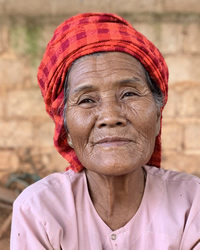Burmese in Myanmar (Burma)

Photo Source:
Anonymous
|
Send Joshua Project a map of this people group.
|
| People Name: | Burmese |
| Country: | Myanmar (Burma) |
| 10/40 Window: | Yes |
| Population: | 29,810,000 |
| World Population: | 30,754,900 |
| Primary Language: | Burmese |
| Primary Religion: | Buddhism |
| Christian Adherents: | 0.35 % |
| Evangelicals: | 0.08 % |
| Scripture: | Complete Bible |
| Ministry Resources: | Yes |
| Jesus Film: | Yes |
| Audio Recordings: | Yes |
| People Cluster: | Burmese |
| Affinity Bloc: | Tibetan-Himalayan Peoples |
| Progress Level: |
|
Introduction / History
The Burmese are the majority and dominant people of the Southeast Asian nation of Myanmar or Burma as it was formerly known. The Burmese or Burma people were originally from the hills of Tibet in western China. Today, they live in Myanmar, and they speak Burmese, a Tibeto-Burmese language.
In modern times, Myanmar has had a long history of coups, wars, and rebellions. Ethnic divisions and political unrest have been common since the first Burmese kingdom in the eleventh century. Myanmar gained its independence from Britain in 1948. Much of modern Burmese history has been one of civil wars between the Burmese majority and the nation's minority groups that includes the Shan, Karen, Lahu, and Rohingya. The military launched another coup in 2021 and is at the time of this writing ruling the country.
What Are Their Lives Like?
Rice is the stable food of the Burmese people. Burmese farmers grow rice in irrigated fields called wet rice farming. They also cultivate tropical fruits, vegetables, palm tree, and coconuts. Most rural families also raise chickens, and a few goats and pigs to supplement their diets. Some Burmese farmers use the slash and burn method of agriculture. With this process, the fields are cut and burned before any new crops are planted. A Burmese farmer often uses cattle and buffalo to draw heavy wooden plows. It is a daily, arduous task for a Burmese family to go out into the fields to grow the family's rice. Mothers work with their babies, while the older children accompany their grandparents. In rural areas, children frequently quit school after a few years to help their family make a living.
Urban Burmese live lives much like they do in Western nations. They work in education, retail, manufacturing, construction, and administration.
The Burmese do not recognize clans or lineages. Marriages are monogamous, and rarely arranged by the parents. Young couples generally live with the bride's parents for the first few years after they are married. Then they will set up their own homes after two or three years.
Various types of houses can be found in the Burmese villages. The wealthier people often live in sturdy, mahogany homes that are raised off the ground and have plank floors and tile roofs. Those with lower incomes may live in thatched roof, bamboo houses that have dirt floors. All activities take place on the dirt floors, including eating and sleeping. Therefore, it is impolite to enter a Burmese house wearing shoes.
The single most important social institution in the village is the Buddhist temple. It symbolizes unity among the villagers and provides a wide variety of activities for the people. The Burmese have a rich tradition of dance, music, poetry, and arts. It is a great honor for a son of a Burmese family to enter a Buddhist monastery.
What Are Their Beliefs?
The Burmese are predominantly Buddhists. The traditional goal in Buddhism is to seek the middle path to Nirvana, or ultimate peace. The Burmese have mixed these Buddhist beliefs with their own animistic beliefs (belief that non-living objects have spirits).
Their animistic beliefs center around inherently evil spirits called nats. The Burmese spend their lives trying to appease the nats so they will be protected from any other evil spirits that may seek to harm them. Typical Burmese homes have altars for the spirits, as well as a statue of Buddha. The village shaman connects the people to the spiritual world. He provides amulets and charms which are supposed to protect the people.
According to their Buddhist faith, the Burmese believe that death is not a threat to one who has done good deeds. Instead, death is simply a "passing" from one life to another. Buddhists believe that those with less merit are reborn as demons, ghosts, animals, or inhabitants of hell.
What Are Their Needs?
Christians make up only a tiny fraction of the Burmese people. Teams of believers can go to villages and provide modern medicine and improved agricultural techniques. Many villages lack electricity so solar panels would greatly benefit the rural Burmese. Most of all, the Burmese need to hear the good news of Jesus Christ. He alone can forgive their sins and free them from their fear of evil spirits.
Prayer Points
Pray that the few Burmese believers would live holy lives, being zealous to grow into the image of Christ.
Ask the Lord to send Holy Spirit anointed workers to the Burmese.
Pray for a spiritual hunger among the Burmese and a desire to read the Burmese Bible.
Pray for just and lasting peace in Myanmar especially between the Burmese and the Rohingya peoples.
Pray for a growing disciple making movement among the Burmese in this decade.